

 Forget Y2K, What
about the chocolate shortage in 2003? Money doesn't grow on trees, the saying
goes, but chocolate sure does. Or, at least the cocoa bean it comes from.
That's why cacao (kuh-COW) tree farmers and chocolate makers like M&M Mars,
Inc., are practically biting their nails with fright! Forget Y2K, What
about the chocolate shortage in 2003? Money doesn't grow on trees, the saying
goes, but chocolate sure does. Or, at least the cocoa bean it comes from.
That's why cacao (kuh-COW) tree farmers and chocolate makers like M&M Mars,
Inc., are practically biting their nails with fright!
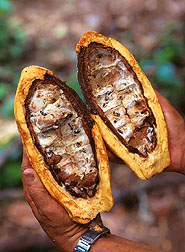 They're worried that chocolate candy, cookies, cakes and other
sweets will be in short supply or, more likely, cost more in the new
millennium. Their worry comes from three types of bad fungi that are attacking
much of the world's cocoa tree crop. Through 1999, fungus attacks have cost
farmers about 3 million tons of cocoa beans already. The fungi must be stopped,
experts say. Otherwise, there could be a world chocolate shortage by the year
2003. That's only three years away! They're worried that chocolate candy, cookies, cakes and other
sweets will be in short supply or, more likely, cost more in the new
millennium. Their worry comes from three types of bad fungi that are attacking
much of the world's cocoa tree crop. Through 1999, fungus attacks have cost
farmers about 3 million tons of cocoa beans already. The fungi must be stopped,
experts say. Otherwise, there could be a world chocolate shortage by the year
2003. That's only three years away!
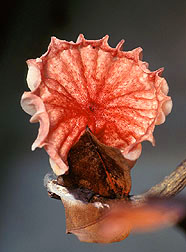 Before you go rushing to the grocery store to stock
up on your favorite chocolate bars, candies, cookies, or syrup, hold on for a
second. There's some good news! Before you go rushing to the grocery store to stock
up on your favorite chocolate bars, candies, cookies, or syrup, hold on for a
second. There's some good news!
Scientists from M&M Mars, the
Agricultural Research Service (ARS) and elsewhere are testing secret weapons.
And oddly enough, their weapons are other fungi.
But these fungi, called
Trichoderma (trick-oh-DER-muh), don't attack cacao trees. Instead, they
protect them--by latching onto the bad fungi and eating their insides.
The battle begins when scientists
spray the good-guy fungi onto cocoa trees infected by the bad fungi, called
black pod rot, frosty pod rot and witches'- broom. Each fungus causes diseases
that rot special pods the cacao tree uses to grow its beans. Then they're no
good to eat. The worst damage has happened in South America, Africa and Asia.
Each is a favorite home of the cacao tree, a tropical species called
Theobroma cacao (thee-oh-BRO-ma).
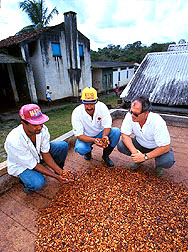 Five to six million farmers on
these three continents now make their living growing cacao trees. They're the
ones helping satisfy the world's sweet-tooth for chocolate. Americans, for
example, eat about 12 pounds of chocolate per person each year. A shortage
could be not only a chocolate lover's nightmare--but also a real hardship for
the folks who make their living from it. Five to six million farmers on
these three continents now make their living growing cacao trees. They're the
ones helping satisfy the world's sweet-tooth for chocolate. Americans, for
example, eat about 12 pounds of chocolate per person each year. A shortage
could be not only a chocolate lover's nightmare--but also a real hardship for
the folks who make their living from it.
Today's chocolate lovers are
carrying on a centuries old-tradition begun by the ancient Aztecs in Mexico.
They called cocoa beans the "food of the gods" and used them as money and gifts
and for religious ceremonies. The Aztecs also roasted and ground the beans and
mixed them with water and corn to make a bitter drink they called
chocolatl, which is where we get the word chocolate. They believed
drinking chocolatl was essential to their diet.
Today, the beans are usually
picked, ground and mixed with milk and sugar to make chocolate. Peanuts and
other foods are often part of the yummy chocolate package.
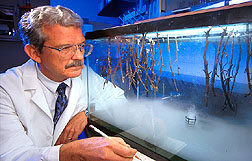 ARS scientists like Robert Lumsden and Prakash Hebbar are
working hard to find natural ways of protecting cacao crops from the bean rot
fungi. "Spraying the trees with chemicals to control the bad fungi doesn't work
very well and costs a lot," says Dr. Lumsden. He's a
plant
pathologist (path-ALL-oh-jist) at ARS' Biocontrol of Plant Diseases
Laboratory in Beltsville, Maryland. ARS scientists like Robert Lumsden and Prakash Hebbar are
working hard to find natural ways of protecting cacao crops from the bean rot
fungi. "Spraying the trees with chemicals to control the bad fungi doesn't work
very well and costs a lot," says Dr. Lumsden. He's a
plant
pathologist (path-ALL-oh-jist) at ARS' Biocontrol of Plant Diseases
Laboratory in Beltsville, Maryland.
There are also few cacao trees
that resist the attack of the fungus, Lumsden adds. His co-worker, Dr. Hebbar,
is a microbiologist who works at M&M Mars in Hackettstown, New Jersey. They
and South American scientists are testing the helpful Trichoderma fungi
as an option to spraying chemicals. And so far, their plan seems to work. In
Peru, for example, they are spraying the good fungi onto cacao trees infected
by frosty pod fungi. That's Peru's main cacao disease.
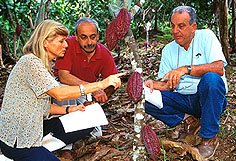  In Brazil, scientists are spraying Trichoderma fungi to
sweep away witches'-broom, the main cacao disease there. One type of
Trichoderma fungus cut the disease by one-third on some infected trees. Lumsden
and Hebbar say the battle is far from over. It's also a team effort that
includes ARS,
M&M Mars, the
American Cocoa
Research Institute and about 10 international research groups. In Brazil, scientists are spraying Trichoderma fungi to
sweep away witches'-broom, the main cacao disease there. One type of
Trichoderma fungus cut the disease by one-third on some infected trees. Lumsden
and Hebbar say the battle is far from over. It's also a team effort that
includes ARS,
M&M Mars, the
American Cocoa
Research Institute and about 10 international research groups.
You can read more about their
rescue effort in the November 1999 issue of ARS'Agricultural Research
magazine. Click
here
to see the story.
--By Hank Becker,
formerly with the Agricultural Research Service, Information Staff
Top/
 |

 Forget Y2K, What
about the chocolate shortage in 2003? Money doesn't grow on trees, the saying
goes, but chocolate sure does. Or, at least the cocoa bean it comes from.
That's why cacao (kuh-COW) tree farmers and chocolate makers like M&M Mars,
Inc., are practically biting their nails with fright!
Forget Y2K, What
about the chocolate shortage in 2003? Money doesn't grow on trees, the saying
goes, but chocolate sure does. Or, at least the cocoa bean it comes from.
That's why cacao (kuh-COW) tree farmers and chocolate makers like M&M Mars,
Inc., are practically biting their nails with fright!  They're worried that chocolate candy, cookies, cakes and other
sweets will be in short supply or, more likely, cost more in the new
millennium. Their worry comes from three types of bad fungi that are attacking
much of the world's cocoa tree crop. Through 1999, fungus attacks have cost
farmers about 3 million tons of cocoa beans already. The fungi must be stopped,
experts say. Otherwise, there could be a world chocolate shortage by the year
2003. That's only three years away!
They're worried that chocolate candy, cookies, cakes and other
sweets will be in short supply or, more likely, cost more in the new
millennium. Their worry comes from three types of bad fungi that are attacking
much of the world's cocoa tree crop. Through 1999, fungus attacks have cost
farmers about 3 million tons of cocoa beans already. The fungi must be stopped,
experts say. Otherwise, there could be a world chocolate shortage by the year
2003. That's only three years away!  Before you go rushing to the grocery store to stock
up on your favorite chocolate bars, candies, cookies, or syrup, hold on for a
second. There's some good news!
Before you go rushing to the grocery store to stock
up on your favorite chocolate bars, candies, cookies, or syrup, hold on for a
second. There's some good news!  Five to six million farmers on
these three continents now make their living growing cacao trees. They're the
ones helping satisfy the world's sweet-tooth for chocolate. Americans, for
example, eat about 12 pounds of chocolate per person each year. A shortage
could be not only a chocolate lover's nightmare--but also a real hardship for
the folks who make their living from it.
Five to six million farmers on
these three continents now make their living growing cacao trees. They're the
ones helping satisfy the world's sweet-tooth for chocolate. Americans, for
example, eat about 12 pounds of chocolate per person each year. A shortage
could be not only a chocolate lover's nightmare--but also a real hardship for
the folks who make their living from it. 

 In Brazil, scientists are spraying Trichoderma fungi to
sweep away witches'-broom, the main cacao disease there. One type of
Trichoderma fungus cut the disease by one-third on some infected trees. Lumsden
and Hebbar say the battle is far from over. It's also a team effort that
includes ARS,
In Brazil, scientists are spraying Trichoderma fungi to
sweep away witches'-broom, the main cacao disease there. One type of
Trichoderma fungus cut the disease by one-third on some infected trees. Lumsden
and Hebbar say the battle is far from over. It's also a team effort that
includes ARS,